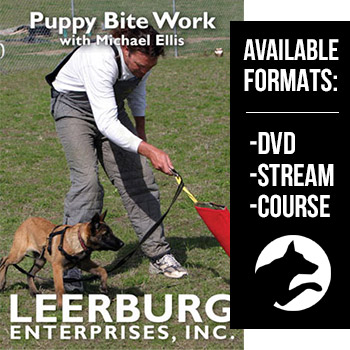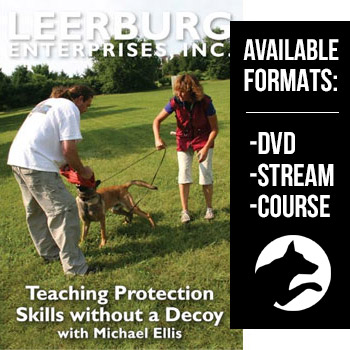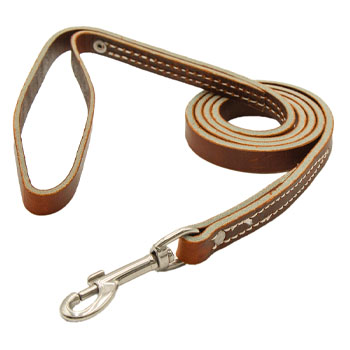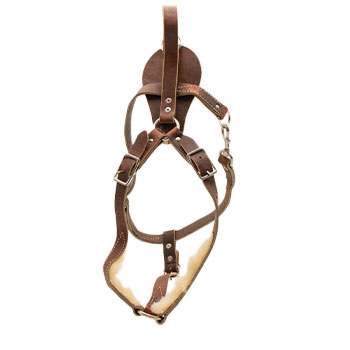November 30, 2011
I have a couple questions about barking and leash pressure during Schutzhund protection work. What would you suggest?
Full Question:
Hi Cindy,Hope you are well. Just wanted to run 2 questions by you and Michael.
1. Deep Bark - in prey drive? I train Sch and would like to do as much as possible with my young dog in prey drive only. He has fantastic drives and a lovely friendly temper and I would like to keep it that way and continue training in prey drive only. This is why I like Michael's system so much. My only concern is the barking at the blind - at high level competitions it is desired that the dog shows what people call 'active aggression' at the Bark and Hold where he barks very intensely with a deep bark meaning 'don't you dare to move Mr Helper'. In the more traditional approach this is achieved by making the dog mistrust the helper, put in in plain words the helper is often being nasty to the dog, or dog being put on a table etc so the helper actually forces aggressive respond and that aggression is trained and rewarded. There are many top sport dogs trained this way and I'm sure they have no problem knowing the difference between the training field and normal every day situations. However I would like not to take the chances and just have my dog liking everybody like he does at the moment. So I was wondering if there are other techniques Michael is using that teach that desired deep barking without the helper somewhat upsetting the dog? I trained my previous dog to do this by using 2 lines (one attached to flat collar and one to pinch collar) and the gentle opposition (not jerking) from the pinch collar created frustration and nicely changed the tone of her bark. But of course this will not be possible with the leash pressure trained dog so hence my question.
2. Leash pressure. How to transition the basic skill to every day walks in stimulating situations? I started teaching it to my 6month old pup (was walked on harness till now) and the problem is my dog treats it like just one of the new tricks. He does this perfectly when I have my rewards with me and he is focused and everything goes as smooth as on your videos. However as soon as we are out and about on a walk he tries to pull - I stop then and continue to keep pressure until he gives away and leash becomes loose, he gets a praise. I haven't seen anything on the videos how do you transition from the basic leash following skill at home to every day life situations. Do I just need to give him more practice at home and garden and gradually increase the exposure to other stimuli?
Many thanks in advance :)

 Cindy's Answer:
Cindy's Answer:
I wouldn’t be too concerned about the barking at this point, with correct training and confidence the barking will come.
I’d recommend Foundation of Puppy Bitework and Teaching Protection Skills Without a Decoy.
These 2 videos will help you a lot with getting your dog prepared for future training while keeping the stress to a minimum. I completely understand the type of barking you need for SchH (I competed for many years in the sport myself) and I feel that you can teach a lot of the barking yourself, or have a friend help. Michael demos that in the video about teaching skills without a decoy.
I teach an informal “walk” command where the dog learns to touch me with his shoulder, this is also shown in the video I mentioned above. It’s called contact heeling. This is black/white criteria for the dog and I don’t need to use my prong to reinforce it (which desensitizes the neck area). It’s used in rear transport for SchH and for defense of handler for ringsport but I also use it for informal walking where the dog shouldn’t pull. I use rewards (food and toy) once the dog understands the basics as taught on the video.
I hope this helps.
Cindy Rhodes
I’d recommend Foundation of Puppy Bitework and Teaching Protection Skills Without a Decoy.
These 2 videos will help you a lot with getting your dog prepared for future training while keeping the stress to a minimum. I completely understand the type of barking you need for SchH (I competed for many years in the sport myself) and I feel that you can teach a lot of the barking yourself, or have a friend help. Michael demos that in the video about teaching skills without a decoy.
I teach an informal “walk” command where the dog learns to touch me with his shoulder, this is also shown in the video I mentioned above. It’s called contact heeling. This is black/white criteria for the dog and I don’t need to use my prong to reinforce it (which desensitizes the neck area). It’s used in rear transport for SchH and for defense of handler for ringsport but I also use it for informal walking where the dog shouldn’t pull. I use rewards (food and toy) once the dog understands the basics as taught on the video.
I hope this helps.
Cindy Rhodes
50% (2 out of 4)
respondents found this answer helpful

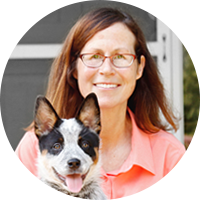
Can't find what you're looking for?



